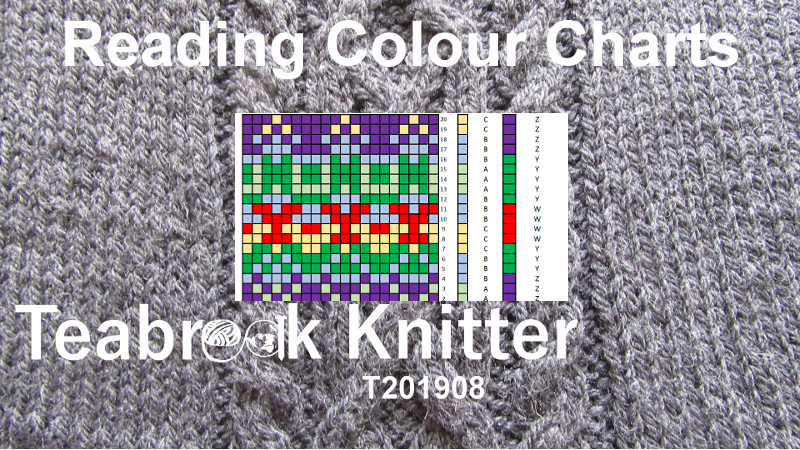Updated May 2020
Charts are often used to provide instructions on how to create intarsia or stranded colour work motifs. This T-torial explains how to interpret and use these charts.
Show notes for the Reading Charts for Colour Knitting T-torial (T201908)
The underlined headings below are links that take you to that section in the YouTube video for this tutorial.
Introduction
I’m Steve, also known as Teabreak Knitter on social media.
In this t-torial, I want to show you how to interpret charts that are often used for intarsia or stranded colour work.
This is what I think about when I see a chart and I am working with it.
General chart properties
Before I show you how I interpret and use charts for colour work, there’s just a couple of things I want to say about charts for knitting in general.
The first point is that the purpose of a chart is to give you a visual impression of how that knitting is going to be knit, and how it’s going to look when the final fabric is made. And so you can see on this chart that you can see the basic shapes that are going to be formed by the stitches. And it’s useful to remember that what you’re looking at is a picture, it might be simplified, of what your knitting is going to look like when it’s finished. That should help you remember some of the basics of a chart.
Charts are numbered up the side side for each of the rows. Whether you are knitting flat or rounds (if you are knitting in the round), you will often have the numbers repeated up the sides here. If you are knitting flat you might find odd numbers on the right hand side of the chart and even numbers on the left-hand side of the chart. That would be to remind you that when you’re on an odd number you’ll be working your way in stitches along in that order [right to left], and when working flat you’ll be working back along the [even numbered] row in the other direction. Because when you are knitting flat and you are knitting from your left needle to the right needle, then the first stitches you do will actually appear on the right hand side of the fabric, and the last stitches of that [row] will appear on the left-hand side of fabric (if you working on the front side of the fabric, on the outside of fabric). On the return, typically a purl row, you will actually be starting at the opposite side. You’ll be starting on the side that when the fabric is finished will be the the left hand side of the fabric and so you need to work your way across the chart in the other direction. Knitting flat you work one way then the other, then the other, then the other. And that’s why in many charts you’ll see the odd numbers written on the right hand side and the even rows numbered on the left-hand side, to remind you which side of chart you’ve got to start. If you are knitting in the round, you always go from right to left because you’re just keeping going knitting in the same direction. You don’t reverse knitting (the direction of knitting) when you working in the round, so you don’t reverse the direction on the chart.
And that’s something that’s very important to bear in mind. A lot of people when they start knitting with charts can be confused about which way [direction] you are knitting.
These columns are also numbered, and that’s the stitch into the pattern repeat. It is not necessarily the same as the number of a stitch in the row.
That’s basic information about all charts used for knitting. That’s the basic difference between reading them for in the round when we are always going right to left, and when we are knitting in the flat where we’re going from the right side row to a wrong side row, going from right to left then from left to right. It is just like remembering that you’ve got to knit, if you are in stockinette, you knit on the outside, and purl on the inside of your fabric.
So, that’s the generic bit about knitting with charts, and I now I’ll talk a bit about knitting with colour in charts.
Using a colour chart
This is a style of chart that is often used in stranded [or intarsia] knitting. It is very clear, and it’s very easy to reproduce in black and white. It’s also very useful if you’re not good at distinguishing between different colours.
In the chart area, these are the various rounds from 1 to 20, and these will repeat several times as you work your way up the project.
Across the way you have got the various stitches, and in almost every project these will repeat as you go round.
The X represents a colour [stitch] in the motif colour.
In this column here, this, the blank, represents a background colour. In the pattern it will tell you what motif colour to use for each of those rounds, and which background colour to use for each of the rounds.
There is no indication on the chart itself of where those changes take place. So you need have a system for reminding yourself when you need to change colour.
There are other ways of representing information on the chart, and here’s another example, perhaps a bit more obvious.
In this the grid, as before, shows you which colour to knit in, but here the colours are represented by the shading of each square, so you’ve got light green, dark green, blue, red, and for each of those colours there will be a key to tell you which colour each coloured square represents.
Here I have just recoloured the monochrome one [chart]. This is quite easy to read if you using a few colours, however if you are using many different colours (7, 8, 9, 10 colours) you won’t get enough contrast in the pattern to be able to put in a close representation of the yarn you are using into the colour pattern, and you’ll find the patterns not only have colours on, but also have different styles of shading to help you distinguish between them [the colours] and, of course, the colour in the chart isn’t necessarily the same colour as the yarn. This may happen with a designer publishing a pattern, but it will almost certainly happen if you choose to change the colour scheme of the item you are [making]. Then you’ll need to remember that a red square represents a white yarn, for example.
This is the principle you are using: each square represents the colour. Let’s go back to the monochrome one [chart].
Many Fair Isle patterns change the motif and background yarns as you go up {the chart]. As you can see here in this pattern there are 3 [rounds of] colour A, 3 of colour B, 3 of colour C. Three colour B, 3 colour A, 3 colour B, etc. And these repeat as you go up. If you have more than 20 ROUNDS, then you go back from ROUND 20 to round 1 when you reach that stage. Similarly, almost every project has more stitches in a round than you have stitches shown in the chart, and in that case you go from 1 to 20, 1 to 20, 1 to 20, just repeating them round as they go.
Now, when you are knitting this yourself, you’re going to need to remember when to change your motif colour and when to change your background colour.
The method I use do this is to actually mark up the chart, like this. What I have done here is that I’ve highlighted between the various rounds when I’ve got to change one of the colours. I used the convention that a red line means I’m changing the motif colour and a green line means I’m changing the background colour. In this chart they don’t both change at the same time, but that thick line there, I use to tell me “look and see what colours you’ve got to change”. It’s a way of reminding me.
That’s the first thing I do to make it simple to use. The other thing that you’ve got to work out is where you start in the chart. If your pattern is for only one size, then you would normally be starting at column 1 and going through to 20 like that. But as soon as you get any shaping you start to run into the issue of where you start in the pattern, and if your pattern has multiple sizes, you’ll often find that some of the sizes start at column one, and others might start at column 10 depending on the size.
So you may want to put on markings to show where you need to start.
For example, I might want to put a mark there to show that in the size I’m making I’m actually starting in column 6 every time I start a new round. (If you have increases or decreases, the rounds may start in different columns, so you would mark the starting column).
Similarly, you may not start at the first row in the chart as you start your knitting. Some sizes of the pattern might, others might not, so you might want to mark on the chart where it is that you are going to be starting, and perhaps also mark where you’re finishing in the chart, both up and down and as you work your way around the round. It’s your chart, your copy. You can mark it up in ways that are useful to you.
And of course you can mark up the colour chart in exactly the same way. Here I have still got those colour boundaries, they don’t necessarily show up as well, but just there as a reminder saying “hey, you’ve got to change the colours”, because even as you’re working your way up you may not notice that you change colours. Unbelievable as it seems, you may not notice while you are knitting, because you get so into the pattern that you forget how to do these things.
That’s the basic way I use the [chart] pattern. The next thing is how on Earth do you remember where you are in the pattern?
That’s why I use a board. I use a magnetic board, like this one, that I can put markers on to. Or, if I am travelling and more likely to knock things, because magnets can move, I would tend to use a clipboard, and ([I keep a supply ] on the back of here) put a transparent sticky label on to show where I’m up to.
Now how do I show where I’m up to? I’ll come back to the monochrome one [chart], because it is less fussy and so easier to see, and I will hold that steady on the board with a few magnets (and, of course, the board’s on a slope so it keeps slipping).
I have this transparent magnetic marker, so if I am about to start working row [round] 8, I’ll put the marker on so that it is showing me round 8. Because this is transparent I can also see the rows that are coming up, but they’re not as important as seeing the round that I am knitting and the rounds that came before it. I’ll explain why these are important.
First of all, it should be obvious why I need to show the round that I am knitting, because I have to remember that’s where I am on the chart.
It is important to see the row [round] below because that will help you avoid making mistakes, because as I’m coming across here, I could just count 1 motif, 3 background, 4 motif, 3 background, 4 motif. What comes next? Where am I? Is it that 4 motifs, or that 4 motifs? You can then look at the round below, and you can make sure your 4 motifs there are covering the background 2 motifs, a background underneath, and the same there. So that you can check that you’ve not missed out a stitch, or put in an extra stitch.
So by being able to look back a round as you are knitting on you can check that you haven’t lost your place and that you are still matching up the pattern.
Moving up the marker, either the magnetic marker on a magnetic board, or transparent sticky marker if you are not using a magnetic board, that will show you which row you’re working on. But both the transparent magnetic marker and the transparent sticky marker can fall off.
When I’m working on a pattern I will often just [make] a check [mark] against each [round] row as I am going up, and each time I do a row I’ll add a check to it, and then use a bar-gate marker, so that I can see easily which round I’m on next.
Many patterns will repeat many times as you go up and, of course, the one advantage of remembering to mark it in pencil on the side is that if you do move the marker (grandchildren, pets move the marker) then you can find where you are again.
Another way of helping you remember where you are is to use a row counter, and because we’re knitting in the round the row counter won’t fit neatly onto your needle. It will push the stitches apart. You want don’t want to do that, so I just tie mine onto a piece of yarn and put that at the start of the round, so as I move through the knitting and I come across this strand of yarn, I know I’m at the start of another round and I can advance the counter. So [that way] I know how many rounds I’ve done.
It’s also useful to [set the counter] so that you’re counting where you are on the chart [remembering that you may not start on the first row and may cycle through the chart several times] rather than necessarily the number of rows, because it’s where you are on the chart that’s the important thing. How many times you’ve been through the chart is quite easy to count.
That’s how I can remember where I am – a bit of belt and braces approach, I use two methods of counting. You definitely need a row marker on the chart you can see where you are on the chart, and you could either keep a record of where you are by writing in pencil on the chart or you can use a stitch counter. Of course you could use all three methods.
That is the basics of how I use a chart when I’m knitting a Fair Isle pattern.
Summary
That is how I use charts when I am doing colour work.
I hope you found this useful. Until the next time, Happy Knitting!
T-Reference
This T-torial supports the T-reference topic Reading Charts.



